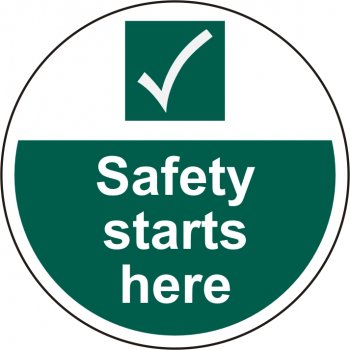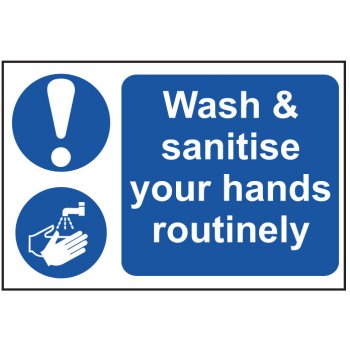The commercial kitchen is the heart of any food establishment, whether it’s a restaurant, café, care home or school canteen. It’s a busy space where meals are prepared and served to customers. However, with all the hustle and bustle, safety, hygiene, equipment, storage, and general signs become crucial aspects that must not be overlooked.
The Occupational Safety and Health Administration (OSHA) reports that slips, trips, and falls are the leading cause of injuries in commercial kitchens. Burns, cuts, and puncture wounds are also common injuries in commercial kitchens.
Therefore poorly organised and cluttered kitchens can increase the risk of accidents and injuries, clear and visible signs can help prevent accidents and injuries by reminding employees of important safety procedures and hazards in the kitchen.
Safety: equipment signage
Safety should be a top priority in any commercial kitchen. With sharp knives, hot stoves, and boiling liquids, it’s essential to have proper safety protocols in place to prevent accidents and injuries.
All kitchen staff should receive proper training in handling equipment, and need signs clearly labelling items such as knives, sinks and chopping boards. These should be colour coded in order to prevent cross contamination; the importance of colour coding equipment such as chopping boards to avoid this, is outlined in our blog Colour-Coded Chopping Boards: Food Safety Guide.
Staff should also be trained in fire safety, including the use of fire extinguishers and emergency evacuation procedures, with emergency and evacuation signs clearly displayed throughout the building to assist them for these purposes. Fire extinguishers should have the correct signage next to them to distinguish the type of extinguisher needed such as dry powder, Co2, water and wet chemicals, all with clear, concise instructions.

Hygiene signs
In addition to training, proper hygiene practices are critical in a commercial kitchen. Foodborne illnesses can spread easily in a kitchen environment if proper hygiene is not maintained. A well organised kitchen with clear signage helps minimise the risk of cross contamination. Staff should follow proper hand-washing before handling food using a dedicated hand washing only sink indicated with signage; utensils should be thoroughly washed in a utensil only sink; and equipment should be regularly cleaned and sanitised.
There are many specific signs that can assist in kitchen hygiene such as:
- Utensil wash only
- Stop: Clean your hands
- Wash food equipment only
- Personal hygiene rules apply beyond this point
- Hair protection must be worn
Equipment reminders
This is where signs in a commercial kitchen really come into play and help remind staff of the proper procedures; how to maintain hygiene, where equipment is kept, and how items are stored. Properly functioning and labelled equipment, surfaces, and areas is essential for the smooth operation of a commercial kitchen. As such it will help to ensure that all equipment is used for its intended purpose and that staff are reminded of safe operations.

Storage prompts and checks
Correct storage practices are critical in a commercial kitchen to prevent cross-contamination and ensure food safety. Dry, raw and cooked foods should be stored separately to avoid cross-contamination, and all food items should be stored at the correct temperature to prevent spoilage, with temperature checks being carried out daily.
Proper labelling and signage of food items, including date of preparation and use-by dates, should also be in place to ensure that expired or spoiled food is not used, which can cause foodborne illnesses.
General safety signage
General signs play a crucial role in ensuring safety and maintaining order in a commercial kitchen. Signs indicating the proper use of equipment, such as “Switch off when not in use” or “No admittance to unauthorised Personnel,” along with warnings of wet floors, hot surfaces or trip hazards, should be clearly posted to prevent accidents and unauthorised access.
Signs indicating emergency exits, fire extinguisher locations, and first aid kits should also be prominently displayed so that staff can easily locate them in case of an emergency.

Warning! Chemicals and hazards
Proper storage and signage of cleaning chemicals and hazardous materials, including what to do if there is a chemical spill and labelling areas where there are dangerous chemicals are also essential in a commercial kitchen. Chemicals should be stored in a designated and locked area, away from customers, food and food preparation areas, and staff should be trained in their safe handling and use.
Furthermore, proper waste disposal practices, including recycling and proper disposal of grease and other hazardous materials, should be followed to maintain cleanliness and prevent environmental contamination.
Signs contribute to a safe kitchen
Safety, hygiene, equipment, storage, and general signs are essential aspects of a commercial kitchen, and something that an EHO will expect to see being displayed and being adhered to. Proper training of staff, adherence to hygiene practices, regular maintenance of equipment, proper storage of food and chemicals, and clear signage can help prevent accidents, maintain food safety, and ensure smooth kitchen operations.
Following these practices can help create a safe and efficient working environment in a commercial kitchen, ensuring that customers are served meals that are prepared with the highest standards of safety and hygiene.
Overall, a well-organised and clearly signed commercial kitchen is essential for maintaining safety standards and reducing the risk of accidents and injuries.
Have you got an inspection looming and could do with some support in preparing? Get in touch and one of our food safety consultants can carry out an audit and provide clear corrective action points or offer support on a particular concern.
Tel: 0845 026 7745
Email: support@cfscompliance.co.uk

